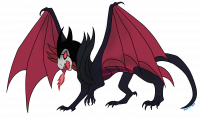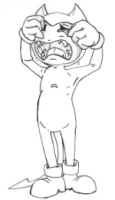| |
| RE: A theory about therianthropy |
|
Posted in: Explanations of Therianthropy Posted by: Observer - 2025-12-13 13:59
|
|
 Oh no, you misunderstood!
Oh no, you misunderstood!
No one is angry or offended, I just want people to think critically and from as many angles as possible. I didn't quite get that from your previous wording but now that you clarified, it makes more sense and I like your thinking a lot more.
Quote:And for your questions about why a specific life would stay with someone over other ones, those are valid questions, and i have to be honest that i dont know. In the original post, i said something along the lines of (sorry if this isnt exact, im writing this in messages bc i have screentime on my browser), but i said like “ik this isnt s very developed theory”, and im sorry o dot havet aswers to every question.
I do encourage you to develop your theory further, these questions should be of help. We all have our own understanding and beliefs and I do like learning what other people are thinking even if I personally disagree. As I said, there are no wrong answers because we can't prove or disprove anything. We just have to think about everything as a whole.
I've always been fascinated with the metaphysical despite holding firm on skepticism. I even have my own thoughts about it, but engaging with other people's ideas is still enriching.
|
|
| RE: A theory about therianthropy |
|
Posted in: Explanations of Therianthropy Posted by: Lynxxie - 2025-12-13 7:00
|
|
 @Observer
@Observer
Thanks for replying to that.
I want to say that i wasn’t trying to present my idea as a universal truth for thrianthropy. I meant it as a personal belief, and i wanted to know other critter’s thoughts on it.. i didn’t mean to that offend anyone by saying that everyone has non-human past lives, im sorry tht i made you angry.
And for your questions about why a specific life would stay with someone over other ones, those are valid questions, and i have to be honest that i dont know. In the original post, i said something along the lines of (sorry if this isnt exact, im writing this in messages bc i have screentime on my browser), but i said like “ik this isnt s very developed theory”, and im sorry o dot havet aswers to every question.
Its (my theory) not meant to be a complete explanation, just a theory I’ve been exploring (as in, a potential reason for some critters, not for all. Im sorry if i came across as trying to make a universal explaination). It will be incompatible with for some critter’s beliefs, and other’s theorys will be incompatible with mine, and if there is a single universal explanation for alterhumanity (which there most likely isnt), then this will almost certaintly not be it (almost, because almost anything is possible). Maybe its because certain ones leave stronger impressions, or that some are easier for the mind to access, or something else entirely. I dont know, honestly. (/no offence meant)
I respect everyones viewpoints, and I’m not trying to say any one (viewpoint, theory, belief, or anything) is better than the others, or more correct, or anything. Im not tryimg to say that any theory is universal or say anyone else’s beliefs are incorrect. I just like talking about ideas (even if they’re wrong, which mine almost all are /half joke)and i also like hearing how others understand their experiences, and finding out other, new, unique viewpoints.
Im sorry i made you angry by posting this theory and responding that way, i didnt mean to. I am really sorry, and if you want me to delete the thread/ edit it in any way then i will. Again, i am sorry i offended you / made you angry.
Alos, aorry if i misunderstood something again
|
|
| RE: What does ‘ doing research ‘ mean to you ? |
|
Posted in: Introduction to Therianthropy Posted by: Observant Demon - 2025-12-12 18:05
|
|
 To me 'doing research' means exactly what the word says. I read what I can on the subject including psychology sites and sources that approach the topic from a objective standpoint and try to take in different perspectives even if it seems uncomfortable.
To me 'doing research' means exactly what the word says. I read what I can on the subject including psychology sites and sources that approach the topic from a objective standpoint and try to take in different perspectives even if it seems uncomfortable.
Doing this helps me to examine what I think I feel and determine whether it is just a passing phase or something else.
As you do more research there is nothing wrong with refining or changing your alignment if you find an aspect or species that more closely harmonizes with your internal feelings.
|
|
| RE: A theory about therianthropy |
|
Posted in: Explanations of Therianthropy Posted by: Observer - 2025-12-12 9:37
|
|
 What I'm trying to say is, it can't be a generalized thing like that.
What I'm trying to say is, it can't be a generalized thing like that.
Now of course, everyone is entitled to their own opinions and beliefs, given we'll never know certain things. But in that fashion, you believing we all have past lives is equally as valid or invalid as someone else believing that past lives aren't real. We'll never have true verifiable evidence of either claim.
With that being said, while your theory is quite interesting (and I believe shared by most spiritual therians), it cannot be the whole truth. I'm not saying it can't be possible, but straight up claiming it as truth and not just a personal belief isn't the right way to go.
I'm mainly referring to this:
Quote:becuse everyone has nom-human past lives
We can't know that.
But to entertain it, how long has my soul lived? Why am I a wolf? Why not a sparrow, an elephant, an amoeba, a carrot... why not all? If my soul lived through countless lifetimes, what about that one life was so incredible for it to persist? Wolves barely have happy lives. Wouldn't my soul wish to immortalize a life as a well-loved pet cat? A moth that didn't know suffering? A beloved son or father who lived in the suburbs with his happy family? How could these be less impactful?
Why a wolf who likely lived a short life filled with hardship, hunger and disease, injury and hurt?
And if the hurt is the point, why am I not a fox who died on a fur farm or a pig who lived all their life confined to a pen barely larger than them before being slaughtered for the unethical meat industry?
How does this work according to your belief?
|
|
| RE: A theory about therianthropy |
|
Posted in: Explanations of Therianthropy Posted by: Lynxxie - 2025-12-12 7:13
|
|
 (To my knowledge) Psychological therianthropy is the belief that critters are therians because of a psycological factor (eg neurodiversity), correct?
(To my knowledge) Psychological therianthropy is the belief that critters are therians because of a psycological factor (eg neurodiversity), correct?
What im saying is that my theory is that (becuse everyone has nom-human past lives, its impossible not to except for like a 1 in 1000000 chance) therianthropy is simply a neurodivergency that causes the memories/feelings/thoughts/other stuff to leak from the past lives into the mind of the present “life”.
Does this make more sense? Sorry if this one isnt clear either/ you still dont think ive included pschologoicl therians.
Also if anyone has already put a theory on here that is similar/ the same as this, it was not my intention to and i genuinely thought it was an original idea, just notify me and i will remove it!
|
|
| A theory about therianthropy |
|
Posted in: Explanations of Therianthropy Posted by: Lynxxie - 2025-12-11 20:49
|
|
 (to give backstory, i believe in reincarnation of animal, human and plant spirits)
(to give backstory, i believe in reincarnation of animal, human and plant spirits)
So basically ive been thinking for a while about why critters are therians, and I thought “if alterhumans are reincarnated nom-human spirits/souls in human bodys, why arent there more therians? There are trillions of insects alone, with billions more of other species (not even counting micro-organisms and single-celled macro-organisms)”
So, why is that? I think it could be because basicqlly each soul has innumerable past “lives”, memorys, feelings, sensory thingys, or even just general emotions transferring into the current live’s conciousness, but (heres the important part)
What if you can only access those transfers with some form of neurodivergency?
Im not talking about having adhd/asd/bpd or stuff like that
(but i have seen a disproportionately large amount of therians with neurodivergences, but that might be unrelated, just because critters with those conditions are used to being marginalised, and it helps them with realising what those transfers are and interpreting them)
What i Am saying though, is that (in my opinion/experience) therianthropy is a combination of having a neurodivergency, and having past non-human lives (and i think therianthropy is just the presence of this neurodivergency, like how people can be neurodivergent but not therians)
I know its not a very well developed theory (imo), but does anyone have any questions / this lines up with anyone else’s experiences or opinions?
Also apologies if i got anything wront/offended anyone, just notify me and ill try nd fix it!
|
|
| RE: What does ‘ doing research ‘ mean to you ? |
|
Posted in: Introduction to Therianthropy Posted by: MustelidLynn - 2025-12-06 4:19
|
|
 For me, doing research means to spend ample time looking things up, rather that be scrolling through forums such as this one, websites, reading books, articles, watching informational videos/documentaries, etc.
For me, doing research means to spend ample time looking things up, rather that be scrolling through forums such as this one, websites, reading books, articles, watching informational videos/documentaries, etc.
To me the best thing you can do is experience. Talk to other therians, or even trusted friends and loved ones. Live out your therianthropy through expression, physically and emotionally, experiment with labels, etc.
Of course you'll need to be careful with those last two sentences. I'm not recommending that you tell others about your therianthropy if you deem it to be unsafe, just for clarifaction! Also, try to stick with what your gut is telling you.
|
|
| RE: Happy therianthropy day! |
|
Posted in: Announcements Posted by: Pinepieee - 2025-12-04 21:52
|
|
(2023-11-27 7:48)DustWolf Wrote: Hey guys,
Happy therianthropy day!
As is our historic custom, therianthropy day is celebrated on the first full moon in November, which is today on the 27th .
To quote @BearX who posted this back in 2017:
(2017-11-04 14:44)BearX Wrote: Today is the first full moon of November, 2017. The first full moon of November has been a sort of de facto "Therianthropy Day" since the mid 1990s. It was when, 23 years ago, on the weekend of November 19 & 20, 1994, the first official AHWW howl was held.
I was unable to attend it, although I did make the two that followed. I was a broke college student and had no transportation at the time. It was fun reading the post-howl reports on the newsgroup, though.
I always felt it was a good time to have an official celebration of therianthropy, since the AHWW newsgroup itself was created in November, 1992. Very momentous for therians, November is.
It was first proposed as a sort of holiday in March of 1996, in this thread on AHWW, should you want to investigate the history. Ultimately, AHWW decided to use it, and it stuck. It went through a few iterations of names, "International Werewolf Day", and then the less species-specific "Awereness Day" (since were is the older term for therian), and after the term therianthropy caught on, "Therianthropy Day".
So, happy "Therianthropy Day". Hope it's a good one.
We never quite figured out what we were going to do for Therianthropy Day. Maybe bake a cake. Maybe be proud and celebrate your therianthropy online by bragging about your animal traits. Maybe just chill out and have that one day in a year when you let your animal side out a bit more than usual. There are no rules on what must be done for therianthropy day. 
If nothing else, it's a day to be true to ourselves and remember what all this is all about.
Take care.
LP,
Dusty
We should have a special item for this that's only available on Therianthropy Day! I feel it should be free of charge, jst something to use to celebrate!
|
|
|







![[-]](images/collapse.gif)

